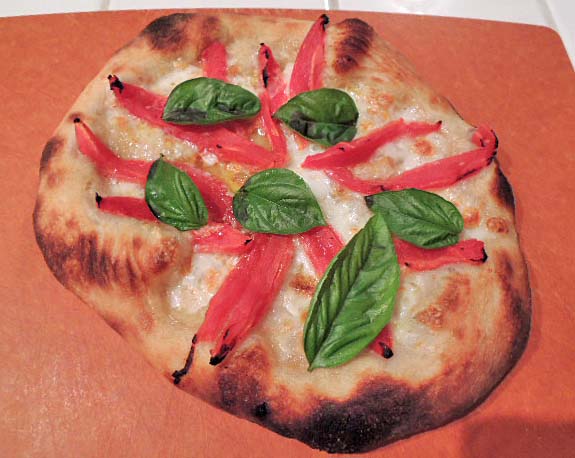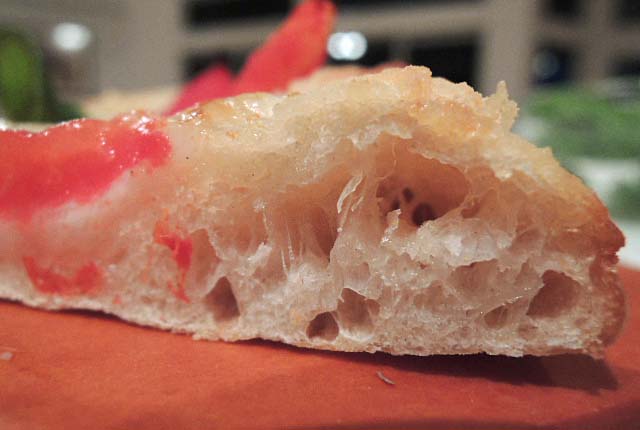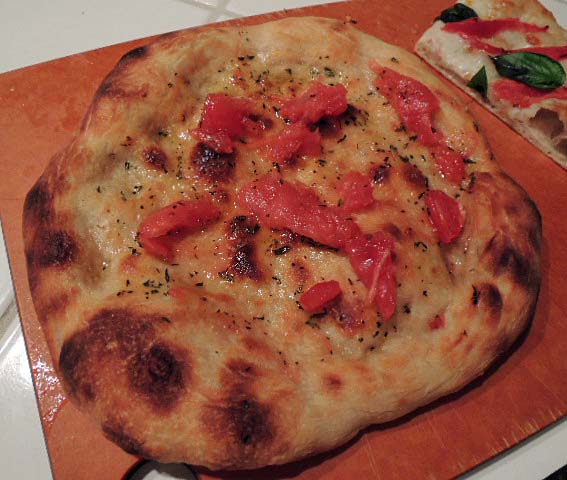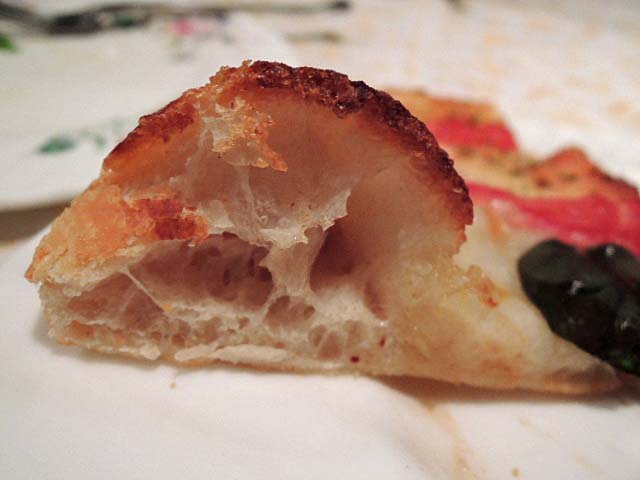
Pizza Bliss

I like pizza quite a lot, but my wife loves it. She told me last night that Pizza is the one food she can “over-eat.” I could not start to list the foods I will predictably over-eat given the opportunity, but my wife has this super-human self-control. So this confession tells you that pizza is really special to her.
I've made some pretty good pizze and some not so good. Last night I made the best pizza I've ever made by a long shot. In fact, I do believe it was the best pizza crust I've ever eaten.
The crust was based on the “Overnight Pizza Dough with Levain” from Ken Forkish's Flour Water Salt Yeast. I say “based” because, while the ingredients and procedures were pretty much as Forkish prescribes, the timing of many steps was different. Some of those differences were planned, and some were …. accommodations. I'm not going to claim that the crust turned out so well because of my baking genius, but I am going to try to capture what I ended up doing so I can do it again … on purpose next time.
Total dough | Wt (g) | Baker's % |
Levain |
| 10* |
Caputo 00 flour | 980 | 98 |
Giusto's fine whole wheat flour | 20 | 2 |
Water | 700 | 70 |
Salt | 20 | 2 |
Total | 1720 | 172 |
* Percent of total flour that is pre-fermented.
Levain | Wt (g) | Baker's % |
Mature, active levain | 25 | 10 |
Caputo 00 flour | 100 | 80 |
Giusto's fine whole wheat flour | 25 | 20 |
Water (90 ºF) | 100 | 80 |
Total | 250 | 190 |
Dissolve the levain in the water.
Add the flours and mix thoroughly.
Ferment at room temperature until expanded by 2 to 2.5 times. (Note: Forkish specifies fermenting for 8 to 10 hours. My levain was ripe in 6 hours. So, I went to step 4.)
Refrigerate overnight or for up to 2 days.
Final dough | Wt (g) |
Caputo 00 flour | 900 |
Water (90-95 ºF) | 620 |
Fine sea salt | 20 |
Levain | 180 |
Total | 1720 |
Take the levain out of the fridge 1-2 hours before mixing the final dough.
Mix the water and flour to a shaggy mass and allow it to rest, covered, for 20-60 minutes (autolyse).
Sprinkle the salt over the dough and add 180 g of the levain divided into 4-6 pieces. Mix using the “pinch and fold” procedure described by Forkish.
Bulk ferment for 5 to 14 hours, or until the dough has expanded 2 to 2.5 times. Do stretch and folds at 30 minute intervals 2-4 times . Then just let the dough ferment undisturbed. (Note: I know this time range (5 to 14 hours) sounds absurd. Forkish's instructions are to ferment overnight for 12 to 14 hours, but my dough had doubled in 5-6 hours and was very bubbly. If I had let it ferment for another 6 to 8 hours, I would have had soup.)
Transfer the dough to a well-floured board. Dust the dough and your hands with flour. Divide the dough into 350 g pieces. (You will get 4 pieces of 350 g and one that is larger.
Shape each piece into a fairly tight ball and place them in ZipLoc-type sandwich bags with a tablespoon of olive oil in each.
Refrigerate for at least 2 hours and for up to 3 days.
When you are ready to make your pizza/e, 2 1/2 to 4 hours before shaping the pizze, take the number of dough balls you will need out of the fridge. Let them warm up at room temperature for 1 1/2 to 2 hours. The balls should expand by a third to a half.
Put the dough balls back in the fridge for the last half hour to an hour before shaping them into pizze. This is because the dough is a bit more elastic and less fragile when cold.
Take one ball of dough at a time out of the fridge. Shape it. Top it. Bake it. Enjoy!
This “in and out of the fridge” stuff may seem unduly complicated. It happened because we changed our minds about going to a concert a couple times before finally deciding to stay home and make pizza. See, if we had decided to go, there wouldn't have been time to make pizza and eat it beforehand. But, in hindsight, this procedure makes a lot of sense. A longer fermentation improves flavor, but retarding the dough in the fridge was needed to prevent over-fermentation. The warm-up in Step 8. just completed the fermentation to an optimal degree. I could have just let the bulk fermentation go a bit longer – say about an hour – and then not needed Step. 8 and 9 at all.
This dough was a delight to shape. It had just the right balance of elasticity and extensibility. When baked at 500 ºF for 10 to 11 minutes, the edges puffed up beautifully. They were crackling crispy. The dough under the toppings was moderately chewy but not at all “tough.” The most remarkable feature was the flavor. It was mildly sour but very wheaty, sweet and complex. It was astonishingly delicious. My wife, who often leaves pizza crust un-eaten, actually left the center part un-eaten and ate the outer crust in preference.
How much of this was the procedures and how much the use of 98% Caputo 00 flour? That's hard to answer. I suppose I need to make this dough again using a good AP flour to find out.
I made two 10 or 12 inch pizze. One was a classic Pizza Margherita made with olive oil, fresh mozzarella, fresh, locally grown San Marzano-variety tomatoes which were par-boiled, skinned, seeded and cut into strips and fresh basel leaves from our garden, added after the pizza was baked.


The other pizza was topped with a heavy spread of good olive oil, fresh, finely chopped rosemary and fleur de sel. After baking, the top was rubbed with a cut San Marzano tomato which was then hand-shredded and spread over the pizza. (Note to self: Lose the salt, if you don't want Susan to complain. Substitute thinly sliced garlic.)



Well, we do have 3 pizza dough balls left, including a 380 g one. I am going to make a potato pizza that's been on my “to bake list” for a few years, ever since I first read about it in Leader's Local Breads then again in Maggie Glezer's Artisan Breads.
Yum!
Happy baking!
David
Submitted to YeastSpotting


Comments
I'll look at the Jamie Oliver video.
I have mostly used Marcella Hazan's pasta recipe, also mixing usually in the food processor then finishing by hand. I've use an Atlas pasta machine for years but recently got the KA attachment. I've used it just a couple of times. I like it.
David
Your welcome, David
I know you love Italian dishes.
Might I suggest some fabulous video's at JamieOliver.com. Beautiful video's, cooking, Italy..to say the least.
Check out Jamie's friend and food guru.
Under video's, Perfect Pasta Dough with Gennaro Contaldo and don't stop there...more of Italy, food, video's with Gennaro's friend. 'Two Greedy Italian's' Antonio Carluccio & Gennaro Contaldo. video's/youtube. Fabulous recipes, check out the Sea Beam and bread served with it...Carluccio's Lemon, Ricotta Tart...many more.
Sylvia
Hi
Am very keen to try this pizza as I have never used my s/d starter in pizza. My problem is that although I have a basic grasp ( very) of bakers % ( thanks to Wild Yeast) and use to scale down straight dough formulas to just enough for one loaf, pizza. etc, whenever there is a levain, poolish or biga used, I get completely flummoxed! I just cannot get my head around the math. As most bread books make more dough than I need, it is important for me to try grasp this concept. Having read of David's experience with freezing this dough, this appears not to be an option.
I wonder if anyone could, or would, scale this particular recipe via bakers % to say one 340g pizza, I may be able to work backwards and get an understanding of the concept. I would be forever grateful.
I live in Adelaide Australia, a small capital city and struggle with ingredient availability compared to US posters, but I have worked around things lot. for example, no supermarket here sells rye flour, let alone the different types or colours. Have to travel about 30mins to get to the only supplier I know of. Doesn't pay to run out in the middle of mixing!
I have learned so much from this site .. it is my go-to recipe finder. Unfortunately, I personally know of no other home bread baker, let alone sourdough bakers, so I have no comparisons to make. No artisan bakeries in my vicinity either. My friends and family are all into supermarket fluffy white plastic bread with heavens know what in it (chicken feathers perhaps?).
Thanks to everyone
Sondra
Hi Sondra, (and David, hope you don't mind me jumping in here, with my reply!)
I'd put David's formula into a spreadsheet - here it is, resized for 340g
Re: freezing the dough, SylviaH offered some tips about that, in the comments in this post.
Happy baking!
:^) breadsong
Here are two ... Count 'em! Not one, but two! ... ways of solving your problem.
1. Learn bakers' math. Here's a tutorial. Baker's Math: A tutorial
2. If you have a recipe for 5 pizza doughs, and you want to make 1 pizza, divide every ingredient by 5. Proceed with the recipe.
Happy baking!
David
Hi
Firstly, Breadsong, thank you for your spreadsheet. Will have to open this up on the desktop or laptop, as my iPad doesn't support Excel. Luckily I know this software, being a Personal Assistant all my working life (which was some time ago). Retired many years ago! This will be invaluable (help to beat alzheimers perhaps?). All this technology .. I should know better at my age, you think?
David, I have seen many tutes on bakers math, but on reading your link a light bulb in my brain suddenly lit up re incorporating the levain's flour/ water amts into the final dough flour/ water amts. I have not had time to study this, as it is a rather busy and stressful time for me, having just recently lost my beautiful young (64yo) brother in- law to melanoma, one of the most deadly cancers in this sun-drenched country.
I will get back to you both in a day or two when I have been able to study this in depth. In the meantime, thank you both for taking the trouble to respond .. it means a lot to a struggling would be bread baker with no other support.
Sondra
I followed the original post and had great success today with the recipe and technique !
David
Dear David,
thanks for posting the recipe. I've been trying to find a pizza dough that uses wild yeast and yields a good, tasty crust. Alas, on a first attempt, I must agree with Franko. Not only it was very hard to shape, tearing easily, a wet sloppy blob in my hands, but the result was a crackerish crust, which I loath. I saved the leftover dough and will try to make focaccia with it.
I wonder if your dough over-fermented with the gluten broken down by protease enzymes. That is a frequent problem with Forkish's doughs. I hope your focaccia turns out well.
David
Yes, I know it is an old post, but I have been searching tfl for pizza ideas. I was interested that you used 00 flour for the levain. I have had some great pizza success with 00 flour just using my regular BF liquid levain. This post has inspired me to start a 00 liquid levain for tomorrow's pizza dough!
So many great ideas on this site. Thanks for sharing yours!
Best regards and happy baking! Ski
Hi David,
I enjoyed reading your account of adapting the Forkish recipe. It looks like a totally different recipe than his, I must say, with different bakers percentages, and somewhat method. I followed his method in the book, wondering if there was a typo in his bakers percentage, because he calls for 250 grs. of levain for 375 grs. of flour, and states the percentage of levain as 25 as opposed to 75 percent. Ditto for water, calls for 225 grs. at 70 percent, whereas it should be 60 percent. Looking at your recipe, you seem to be following the bakers percentage in the book as opposed to the quantity column. His recipe is written following the quantity column. So, there's a big discrepancy between 25 percent and 75 percent of levain. You also didn't add salt first, and went onto mixing it yeast, flour, water, autolyse, then salt method. Forkish specifically instructs to reverse the order and use salt, water, yeast, flour. He says, using salt first helps the dough withstand a longer fermentatiom outside of the fridge.
Having said all, my dough yielded mediocre results. My oven only goes up to 525. Broiler temperature is even lower at 500. The dough needed more time than 5 minutes to bake in the oven, in which case, it became crackerlike. The third one was the best, because I moved the stone higher up amd used a judicious amount of flour shaping and loading it. Forkish says with this wet dough not to worry about overusing flour. I just wanted share my experience with you and ask you about your percentage and method, which seem so different than Forkish's. Thanks in advance.Happy baking
When Forkish specifies a baker's percentage for levain, he is giving the percent of total flour that is pre-fermented. So, it's the percent flour in the levain with the total flour being 100%. Hope that's clear.
The second issue is that the pizza recipe used in this posting is derived from FWSY. The method you are describing is in Forkish's pizza book, if I am not mistaken.
David
Thanks, David. Coincidentally I was at a bookstore today and looked at his first book, which made me realize where you got your recipe. What's interesting is that the two are very different. Also, thanks for clarifying the baker's percentage. It's more complicated that it seems. I'll keep on experimenting with leavened pizza dough. So far, neither Reinhart nor Forkish recipes worked out for me.
....but have any of you tried the sourdough pizza recipe in Forkish’s THE ELEMENTS OF PIZZA?
The book as a whole is fantastic. I like it better than:
though some recipes in both (I’m looking at you potato pizza from Lahey) make them worthwhile.
The jury is still out on Reinhart’s PERFECT PAN PIZZA. Might be a little too fussy. Haven’t baked anything from Gemignani’s THE PUZZA BIBLE yet.
Anyway: I’d say Forkish’s methods yield significantly better dough than those others. The sourdough pizza is almost magical. And the methods all around are different. He says in the beginning of the book that pizza isn’t bread. So it’s mixed differently and treated differently.
I would be very interested to know if anybody has made pizza from FWSY and them made pizza from his updated methods in THE ELEMENTS OF PIZZA.
I think that book is a game-changer for the at-home pizza maker. I’m surprised it’s not gotten more press around here.
Pages